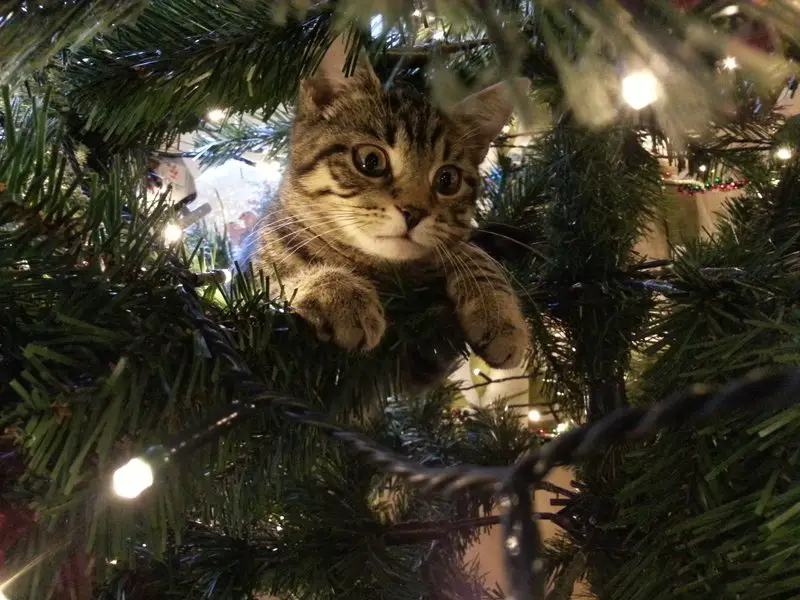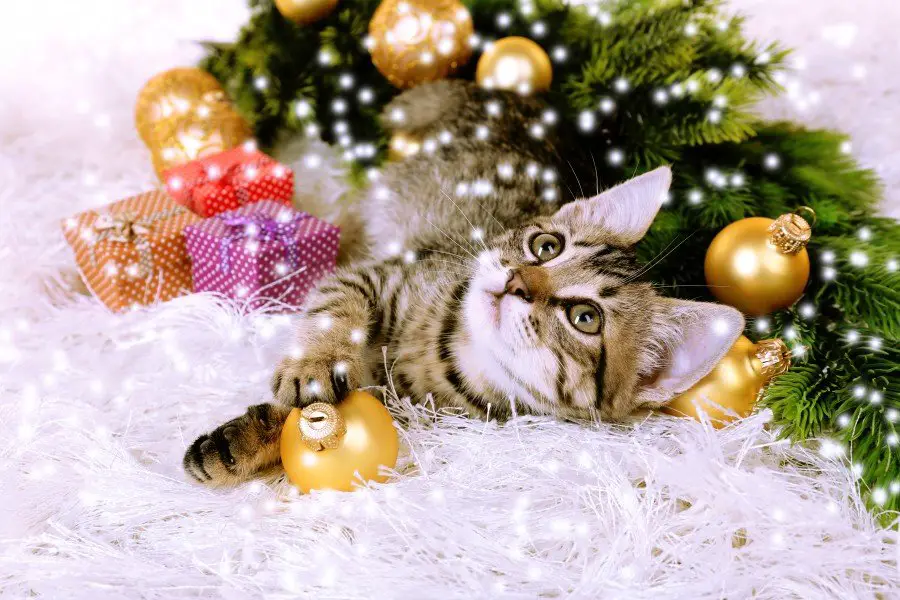The holidays can be both a fun and frenzied time of year. So what are the major dangers that cat owners should look out for at the holidays to ensure that kitty stays safe? Here are the major areas to be on the lookout for to keep your cat safe.
The Christmas Tree
The Christmas Tree itself can pose a hazard if ingested. Most Christmas trees are fir trees, though there are some pine trees. Fir trees are less toxic than pine trees, but both are toxic to cats. Fir trees tend to be less toxic and the reaction your cat has to tree material is usually related to the amount of tree ingested. Additionally, swallowing the pointy needles also poses a hazard. The needles are dangerous, because if swallowed, they can puncture internal organs or cause an intestinal obstruction. Artificial trees pose the same risks. Any material ingested from artificial trees is potentially toxic and can cause punctures or obstructions in the the cat’s intestines.
So what are some signs that your kitty may be sick? If your cat is drooling excessively or vomiting, please seek the advice of your veterinarian. Any changes in your cat’s eating habits should also be taken seriously.

Holiday Plants
Mistletoe, sap from Poinsettias and Holly are very toxic to cats. Be sure to keep the plants away from your cat and take notice if you see your cat drooling, vomiting, or having seizures. If the situation is severe, coma and death are possible. Mistletoe and Holly are considered to be moderately to severely toxic and your cat should be isolated away from these plants.
Bulb Plants
Christmas time is a popular time to give plant bulbs like Lilies, Daffodils, Narcissus and Amarylis to people as gifts. Cats that ingest this plant material become very sick. Cats may exhibit vomiting, drooling, seizures, cardiac arrhythmias, kidney failure, convulsions and death.
Ornaments and Tinsel
Keep ornaments and tinsel away from pets. These shiny, sparkling objects look like irresistible toys to your cat. The slightest movement can create a glimmer that may have your cat pouncing on the tree! The tinsel, if ingested, can bunch up in the cat’s intestines and cause blockages and other problems. Keep glass and other fragile ornaments near the top of the tree if you have them. If these ornaments break, the shards can be particularly dangerous. Cats that play with the shiny shards can receive lacerations on the mouth, and if ingested, their intestines can be severely wounded as well.
Holiday Food
Many people like to involve their pets in the holidays and food often plays a huge part of traditions and celebrations. Try to resist giving your pet table food. In particular, stay away from offering your cat chocolate, nuts, bones, uncooked meat, uncooked bread dough and many herbs and aromatics like onions and garlic. Cats may experience vomiting, upset stomach, nausea, diarrhea, seizures and in extreme cases, death. Instead, why not try a cat food in a flavor that is similar to what you’re eating? Merrick Cat Food comes in fun flavors like “Thanksgiving Dinner” and “Grammy’s Pot Pie” and their cat food is healthy to boot!
Ribbons from Gift Wrap
Cats love to play with gift-wrap and especially the ribbons! Don’t be tempted to dress your cat up in ribbons or a ribbon collar or use the ribbons as a toy. If a cat eats the ribbon, the ribbon can get caught in the cat’s intestines and cause major problems. Ingested ribbon can lead to emergency surgery and sometimes death… be sure to take notice if your cat is not feeling well or isn’t behaving normally. Never leave a cat unattended around ribbon or string.
Lights and Candles
Like ornaments, cats are attracted to the twinkling lights of a Christmas or holiday tree. Many cats are “chewers” and will chew on the cords of these lights. If that happens, you risk your cat getting electrical shock or burns and in some instances, death by electrocution. Use an abundance of caution with candles as well. Cats walking next to an open flame may get too close and knock over the candle, causing a major fire hazard, or they could even get hot wax on them. Their tail, wagging or swaying, could even catch fire (this actually happened to a cat of mine many years ago) – and while all ended well, I’ve never lit a candle since! If you do light candles and have cats, be sure that the candle is in a place that is safely out of the reach of where the cats can access it. Also consider using candle covers or Candle shades. Many companies sell covers, especially for popular jar candles. Or you might consider using candle warmers
. Since the infamous candle incident years ago, I only use candle warmers. They’re really lovely, melt the wax and you get the same great scent – but no fire hazard! Just remember to turn it off.
To lighten things up, because this was kind of a depressing article – here’s a cute video by Cole & Marmalade showing you how cats see Christmas! Do you have any other tips you’d like to share? Please add them in the comments! Have a safe and happy holiday season! …and remember, when in doubt, always seek the advice of a licensed veterinarian. None of the information here is intended to be advice or a substitute for visiting your vet.
What Cats See at Christmas...
No Description
